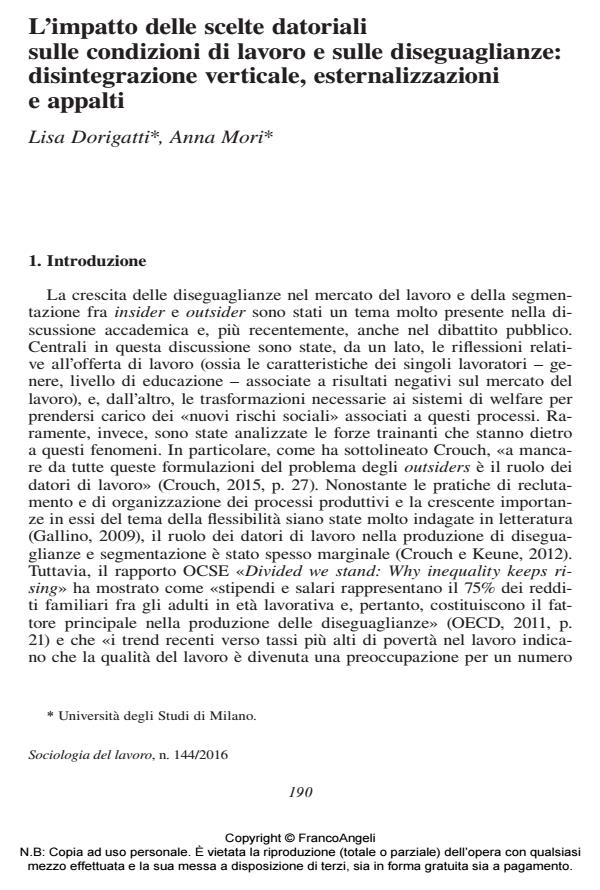The impact of employer’s choices on working conditions and inequalities: vertical disintegration, outsourcing and subcontracting
Journal title SOCIOLOGIA DEL LAVORO
Author/s Lisa Dorigatti, Anna Mori
Publishing Year 2016 Issue 2016/144
Language Italian Pages 15 P. 190-204 File size 100 KB
DOI 10.3280/SL2016-144012
DOI is like a bar code for intellectual property: to have more infomation
click here
Below, you can see the article first page
If you want to buy this article in PDF format, you can do it, following the instructions to buy download credits

FrancoAngeli is member of Publishers International Linking Association, Inc (PILA), a not-for-profit association which run the CrossRef service enabling links to and from online scholarly content.
The increasing segmentation of the labour market and the growth of differences between insiders and outsiders has been a major concern for the academic literature and, more recently, the public debate. Rarely, however, the driving forces determining such phenomena have been analysed or questioned. In particular, the role of employers’ strategies in producing segmentation has been substantially neglected. Still, corporate practices such as vertical disintegration have been strongly associated with the growth of bad jobs and of insider/outsider divides. This paper discusses these issues exploring how the organisational practices of organisations from the public and private sector have contributed to produce inequalities among the workforce involved in their activities. Thereby we will argue that it is necessary to place employers’ strategies into the debate on inequalities and labour market segmentation and that policies targeted to improve job quality and reduce bad jobs should focus not only on the supply side of the labour market, but also on the demand side.
Keywords: Vertical disintegration, inequalities, employers, working conditions
- How Do Employers Choose between Types of Contingent Work? Costs, Control, and Institutional Toying Chiara Benassi, Andreas Kornelakis, in ILR Review /2021 pp.715
DOI: 10.1177/0019793920944910 - Employment Relations in Outsourced Public Services Anna Mori, pp.1 (ISBN:978-3-030-24626-6)
- Trasformazioni, valori e regole del lavoro Piera Campanella, pp.207 (ISBN:979-12-215-0507-8)
- Employment Relations in Outsourced Public Services Anna Mori, pp.59 (ISBN:978-3-030-24626-6)
Lisa Dorigatti, Anna Mori, L’impatto delle scelte datoriali sulle condizioni di lavoro e sulle diseguaglianze: disintegrazione verticale, esternalizzazioni e appalti in "SOCIOLOGIA DEL LAVORO " 144/2016, pp 190-204, DOI: 10.3280/SL2016-144012